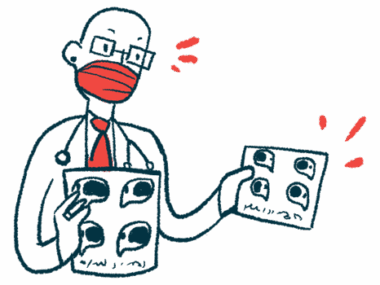Typical Cushing’s symptoms not recognized by patients, study finds
Patients less likely than clinicians to ID disease features, even when severe
Written by |

People often do not recognize the typical symptoms and features of Cushing’s syndrome, regardless of their severity, which contributes to a delay in diagnosis, a study found.
Moreover, there was a discrepancy between the number of symptoms reported by individuals with Cushing’s and those assessed by clinicians — with fewer disease manifestations identified by patients than by physicians.
“Regardless of disease severity, patients often do not complain of the typical features of [Cushing’s syndrome] that are crucial for formulating a diagnosis, the researchers wrote.
According to the team, “this study may aid in the early detection of [Cushing’s syndrome] by identifying symptoms that patients are unable to recognize.”
Titled “Diagnostic dilemma in Cushing’s syndrome: discrepancy between patient-reported and physician-assessed manifestations,” the study was published in the journal Endocrine.
Failure to recognize Cushing’s symptoms may lead to diagnosis delay
Cushing’s syndrome is a group of conditions marked by chronic and excessive exposure to the hormone cortisol. Cushing’s disease is a form of Cushing’s syndrome that’s caused by tumors in the brain’s pituitary gland, which signals the adrenal glands, sitting atop the kidneys, to produce too much cortisol. Adrenal Cushing’s syndrome, or ACS, is another form of Cushing’s that is caused by tumors in the adrenal glands that lead to the excessive production and release of cortisol.
Because many symptoms related to Cushing’s syndrome are nonspecific and common in metabolic disorders — such as obesity, high blood pressure, osteoporosis, and diabetes — identifying Cushing’s can be challenging.
This is even true for some features typical of Cushing’s, such as a rounded or so-called moon face, central obesity, or a hump behind the shoulders, known as a buffalo hump.
Given that the disease’s features are similar to those of primary obesity, not recognizing them correctly can lead to misdiagnosis. This is compounded by the fact that some Cushing’s symptoms are not well known among the general population, as is the case with purple stretch marks or thin skin that’s prone to bruising.
Overall, it may be difficult for people, including primary care physicians with less experience with this rare disease, to recognize Cushing’s. In fact, a study showed that it took an average of almost four years from the onset of symptoms to a Cushing’s disease diagnosis, with patients seeing multiple medical professionals along the way.
Now, a research team in Japan aimed to identify differences in patient-reported and physician-assessed manifestations of Cushing’s that could stand in the way of an early diagnosis.
“Few comprehensive reports have focused on this issue or investigated whether patient-reported manifestations are consistent with physician-assessed symptoms of [Cushing’s],” the researchers wrote.
Of the 52 patients involved in the study, five were men and 47 were women, with an overall mean age of nearly 50. Among them, 16 had Cushing’s disease, and 36 had ACS. Most had some co-existing conditions: 43 patients had high blood pressure, 44 had blood sugar metabolism impairment, and 29 had osteoporosis.
The median time from the patients’ initial recognition of symptoms to diagnosis was 44 months, or almost four years, with patients visiting a median of three medical facilities before being diagnosed. For more than half of the patients (58%), getting a diagnosis took more than three years.
Physicians urged to take ‘more proactive approach’ in examining patients
Upon diagnosis, the team examined medical records to review the patient-reported and physician-assessed manifestations of typical and non-specific Cushing’s features.
When examined, typical Cushing’s features (e.g., moon face, central obesity or buffalo hump, stretch marks, skin bruising or thinning, and muscle weakness) were recognized by physicians, but not by patients. Nonspecific symptoms (e.g., high blood pressure, acne, swelling, abnormal hair growth, diabetes, or osteoporosis) were identified by both.
“This suggests that the discrepancy between patient-reported and physician-assessed manifestations was more significant for typical than for nonspecific features,” the researchers wrote.
[Physicians] have been shown to be aware of [Cushing’s]-related symptoms, especially typical features, whereas patients do not recognize these manifestations, even when the disease is severe. … Therefore, the key to the early diagnosis and treatment of [Cushing’s syndrome] is a more proactive approach of questioning and examining patients suspected of having the disease.
The total number of typical symptoms reported by patients was lower than that described by physicians (1.0 vs. 3.5). Moreover, patients reported four of the five typical features less often than physicians, with the exception of muscle weakness.
Physicians “have been shown to be aware of [Cushing’s]-related symptoms, especially typical features, whereas patients do not recognize these manifestations, even when the disease is severe,” the authors wrote. “Therefore, the key to the early diagnosis and treatment of [Cushing’s syndrome] is a more proactive approach of questioning and examining patients suspected of having the disease.”






